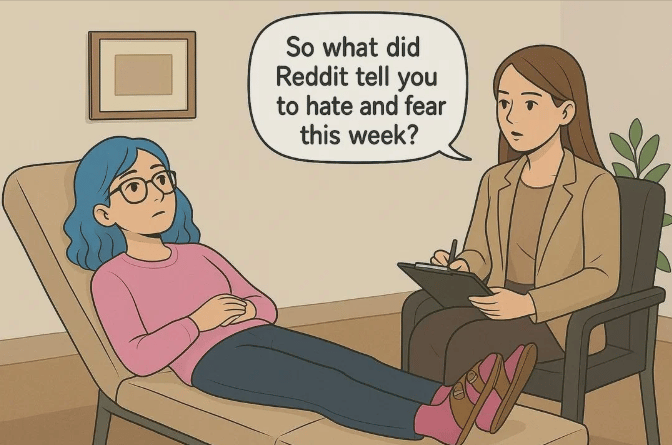
Volume 094
“If you switched bodies with the person you love the most for a year, how would you take care of their mind and body knowing you’d be giving it back to them? How would you take care of that person you love the most? Now do that for you.”
This quote has stuck in my brain since first coming across it. We all have someone in our lives we’d move mountains for - a partner, a child, a parent, a friend. If their mind was overwhelmed, we’d tell them to rest. If their body was hurting, we’d insist they slow down. If they were doubting themselves, we’d offer compassion long before criticism.
It’s strange, isn’t it? How easily we extend grace outward, yet hesitate to offer even a fraction of it inward. We are quick to intervene when we see friends making damaging decisions to their mind or their health - but we tend to not be as quick with ourselves.
Imagine just for a moment, that you had to care for your own body and mind as if they belonged to the person you treasure most. How would your internal dialogue change? Your diet? Your workout routine? Your patience?
Maybe the gap between how we treat ourselves and how we treat others is the clearest sign that our self-care is less about indulgence and more about alignment.
Superset of the Week:
Brain: - Why an Optimistic View of AI Still Makes the Most Sense

Mark Manson recently wrote about (and discussed on a podcast) taking a level-headed, optimistic stance toward AI. In typical Mark fashion, this was a refreshing break from the mainstream media’s usual “robots will erase humanity” headlines. His point wasn’t that AI is harmless or that everything will be wonderful. It was that we’re historically terrible at predicting the future, especially with emerging technology, and fear-based narratives often crowd out nuance.
That’s worth expanding on, because the noise around AI has reached a fever pitch. For every claim that AI will replace all jobs next year, there’s someone promising it will solve every human problem. Neither is grounded in reality. What is grounded is this - AI is becoming a part of everyday life, not as a takeover mechanism, but as a tool. One that’s already making people more capable, creative, and efficient when used intelligently.
Look at what’s happening in education right now. I read an article in the WSJ about teachers who use AI to build personalized study guides for students who struggle with attention or processing speed. These aren’t futuristic models - they’re tools available today, helping kids who would otherwise get left behind. One professor in the piece has his students use AI to rewrite their essays in multiple styles so they can analyze the difference between “good,” “great,” and “lazy” writing. Instead of fearing AI plagiarism, he’s teaching them how to think critically with technology.
Or consider how working adults are using AI. Companies are employing AI to draft customer responses, reducing email backlog from three hours to thirty minutes. A colleague of mine (parent, successful, BUSY) uses AI to summarize articles he doesn’t have time to read so he can stay informed during a season when time is scarce.
None of these people think AI is magic. They just use it as leverage.
The point is AI isn’t some distant theoretical force. It’s already woven into daily routines in ways that make life a bit smoother, a bit fairer, a bit more accessible.
And that’s why cautious optimism is the most rational stance. When you strip away hype and fear, you’re left with a simple truth that AI’s largest near-term impact will be improving human capability, not replacing it. We’ll see faster problem-solving, better personalized learning, more efficient healthcare workflows, and new opportunities for people who previously lacked access or time.
This doesn’t mean ignoring real risks. It means recognizing that every major technological shift, from electricity to the internet, came with anxiety, adjustment, and ultimately, massive long-term benefit.
If you stay curious, experiment with small use cases, and learn how AI can support the work you already do, you’ll be ahead of 99% of people who default to fear instead of exploration.
Optimism here isn’t wishful thinking. It’s strategic. Because the future belongs to people who learn to use the tools that shape it.
Body - Thanksgiving Movement Made Simple

As we discussed last week, Thanksgiving week has a way of throwing your routine into the blender. Travel, family, big meals, weird schedules, and the general vibe of “I’ll get back to it next week.” But this is exactly the moment where small, repeatable actions matter most. You don’t need a gym. You don’t need 60 minutes. You just need a plan that lowers the barrier and keeps your momentum alive.
To continue on our protocol laid out in Vol 093 Here are three no-equipment workouts - beginner, intermediate, and advanced - that blend strength and cardio, take 20 to 40 minutes, and can be repeated throughout the week no matter where you’re celebrating.
(20–30 minutes): “Holiday Warm-Up”
A simple circuit designed to raise your heart rate, build foundational strength, and leave you feeling energized—not drained.
Circuit (3–4 rounds):
30 seconds bodyweight squats
20 seconds rest
20 seconds incline push-ups (kitchen counter or couch)
20 seconds rest
30 seconds glute bridges
20 seconds rest
30 seconds fast marching in place (drive knees high)
40 seconds rest
Low impact, full-body, and perfect if you’re short on time or easing back into movement.
(25–35 minutes): “Turkey Burner”
More volume and intensity with plenty of strength-to-cardio transitions to boost metabolism.
Circuit (4–5 rounds):
40 seconds air squats
20 seconds rest
30 seconds push-ups
20 seconds rest
40 seconds alternating reverse lunges
20 seconds rest
30 seconds mountain climbers
40 seconds rest
Challenging but manageable. Strength moves elevate your metabolism, while short cardio bursts keep your heart rate up without destroying your legs for days.
(30–40 minutes): “The Thanksgiving Challenge”
A higher-intensity session you can repeat during the week when you need a sweat that hits every system.
Circuit (5 rounds):
45 seconds jump squats
15 seconds rest
40 seconds push-ups or decline push-ups
20 seconds rest
45 seconds alternating split squats (or lunges)
20 seconds rest
40 seconds burpees
45 seconds rest
Strength. Plyometrics. Full-body conditioning. A perfect holiday-week workout when you want to feel dialed in and ready for the day.
Simple Ways to Stay Active All Day (Even if You Skip the Workout)
Movement doesn’t only happen in workouts, especially this week. Here are easy, low-friction ways to stay active without disrupting family time:
Take a 10-minute walk after each meal (helps digestion and blood sugar control).
Offer to run errands, set the table, or help with cooking - stay on your feet.
Do 10 squats every time you refill your drink.
Turn commercial breaks into mini movement snacks.
Go on a morning or pre-dinner walk with a family member you want to connect with.
This week isn’t about perfection. It’s about preserving momentum. A 20–30 minute workout (or even a walk) keeps you feeling grounded, makes eating decisions more intentional, and reinforces that your health is part of your identity, not something you need a break from.
Book - The Gift That Keeps Giving

The gift giving holiday season is rapidly approaching, and I want to encourage you to think differently about the gifts you give this year, or at least think about an additional item to wrap alongside - that is, a book.
There’s something uniquely powerful about giving someone a book for the holidays. Unlike most gifts, a book isn’t just an object - it’s an experience. A doorway. A nudge. A momentum shift waiting to happen at exactly the right moment. When you match the right book to the right person, it can meet them in a way few gifts ever do.
Think about where the people in your life are right now. A friend stepping into a new season of growth. A sibling feeling stuck. A parent rediscovering old passions. Books can be bridges - small, thoughtful gestures that say, “I think you might benefit from this” without having to spell it out.
And curation matters. In fact, it matters the most for this gesture. Anyone can hand someone a random bestseller. But choosing a book intentionally - something that reflects who they are, what they’re facing, what they dream of, or sharing something you really enjoyed - turns a simple gift into something personal. It shows attention. Care. Presence. That you weren’t just checking a box, you were thinking about them.
The ripple effect is real, too. Sharing books you’ve loved creates unexpected connections. It’s an invitation for someone to step inside the same story, idea, or insight that moved you. Suddenly you’re talking about characters, concepts, and lessons with a shared vocabulary. Families adopt new traditions. Friend groups build mini book clubs. A single gift becomes a thread that weaves people closer together.
And my favorite to elevate the entire gesture? Write a note on the inside cover. A sentence or two about why it mattered to you. A moment it helped you through. A hope for what it might spark in them. That tiny personal touch can turn a $15 paperback into the most meaningful gift they unwrap this season.
In a season filled with material exchange of things we all know we don’t really need, gifting a book is a small, quiet act of generosity that lingers long after the holidays fade. Stories stay. Ideas stick. And sometimes, a book arrives at exactly the right time to change something in someone’s life.
So as you’re thinking about gifts this year, whether standalone or tucked alongside something else, consider giving the people you love the same thing books have given you - new perspective, inspiration, hope, laughter, escape, momentum.
Haven’t read anything recently to have an idea of what to gift? Now there’s a problem you should probably start working on fixing :)
Breakthrough of the Week - Spotify E-Books
I mention this about once a quarter here, but in conversation I continue to find it is an under utilized perk. Spotify, for all of you with Premium accounts, offers 15 hours of free audiobooks a month. Most books are on there for free, and others are available for purchase.
I love the experience of a hardcover book, and will never replace that, but when on the road or getting some extra cardio in, it is really nice to be able to pick up where I left off in my physical version on the go in audio form.
The cost of Audible is crazy to me. This is a great alternative.